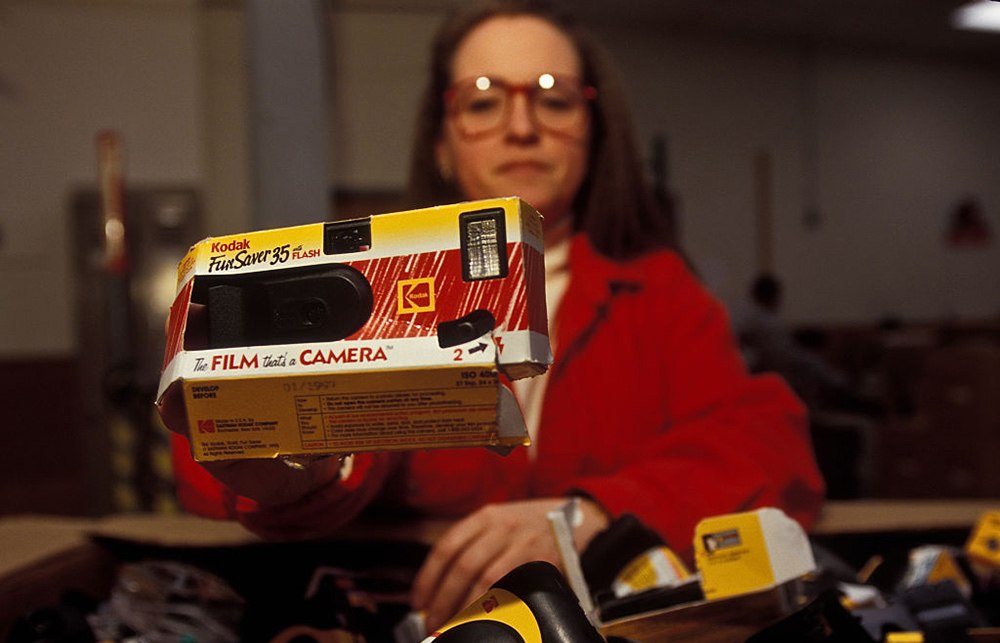传奇相机制造商伊士曼柯达公司(Eastman Kodak)在周二宣布了一条惊人的消息:美国政府将向其提供高达7.65亿美元的贷款,用于仿制药生产,以强化美国本土供应链,从而应对新冠病毒大流行。
柯达的首席执行官吉姆•科伦扎向《华尔街日报》表示,预计制药业务最终将占其业务的30%至40%。
在柯达宣布获得政府贷款后,该公司的股价暴涨了318.14%。周二收盘时,该公司的市值从1.15亿美元升至3.47亿美元,创下了该公司有史以来的最佳单日涨幅。
从胶卷生产和医疗成像业务转向制药领域,这一让人匪夷所思的转变其实并不新鲜。柯达不过是走上了昔日竞争对手日本富士胶片控股公司(Fujifilm Holdings Corp.)的老路。

在20世纪的大部分时间里,柯达和富士几乎垄断了胶片摄影行业,但到目前为止,事实证明富士比柯达更善于“自我改造”。
1975年,一位柯达工程师发明了第一台数码相机,但公司并没有意识到这项技术的潜力。而富士公司则更快地转向数码技术,在1988年推出了世界上第一台便携式数码相机,并且让这家日本公司更快地摆脱了胶片业务的局限。
同样在制药领域,富士也比柯达领先了好几步。到2019年,医疗保健和材料解决方案收入占富士总收入的43%,该公司还计划在未来几年将医疗保健部门的销售额翻一番。
该公司早在1986年就收购了一家医疗影像诊断公司。此后,富士又收购了几家生物制药公司,将自己打造成了医疗设备和药品的主要生产商。
2006年,它收购了制药公司富士胶片富山化学公司(Fujifilm Toyama Chemical),后者研发出了抗病毒药物法匹拉韦(Avigan),是新冠病毒治疗药物研发的早期竞争者(不过,本月初的临床研究尚无定论,这削弱了人们对法匹拉韦研发的热情)。
周一,富士在2013年收购的生物技术科技公司Fujifilm Diosynth Biotenologies宣布,作为美国政府新冠病毒疫苗研发计划“空间机站行动”(Operation Warp Speed)的参与者,其得克萨斯州工厂将支持生产冠状病毒候选疫苗。
曾经几十年在美国相机和胶卷市场上占据主导地位的柯达,在行业中挣扎数年后,于2012年申请破产保护。2013年走出破产困境后,该公司更名为一家专注于商业印刷和商业成像业务的科技公司。
这两家公司均由影像业转型制药业并非巧合。柯达和富士都表示,它们先前生产胶卷以及各类影像产品的经验完全适用于药品生产。
在接受《华尔街日报》采访时,科伦扎表示,柯达“在化工品、先进材料的制备上有着相当悠久的历史”,并表示公司现有的基础设施可以让柯达制药“迅速投入生产”。
早在进军制药业数年前,富士就发起过名为“全面医疗保健公司”的活动。而现在富士坚称,其制药业的成功与其影像业的过往经验密不可分,并在官方网站表示,公司研发药物时专门采用了“富士由来已久的独家胶片制作技术”。
白宫顾问彼得•纳瓦罗表示,此次疫情暴露出了美国“对外国基本药物供应的过度依赖”,并称此次柯达的转型是“美国向自主制药迈进的一大步”。
目前,中国是全世界最大的药品原料供应国,可生产大量用于药品制备的活性成分,美国从中国进口的原料近年来也有所增加。(财富中文网)
编译:刘心辰、杜心邈
传奇相机制造商伊士曼柯达公司(Eastman Kodak)在周二宣布了一条惊人的消息:美国政府将向其提供高达7.65亿美元的贷款,用于仿制药生产,以强化美国本土供应链,从而应对新冠病毒大流行。
柯达的首席执行官吉姆•科伦扎向《华尔街日报》表示,预计制药业务最终将占其业务的30%至40%。
在柯达宣布获得政府贷款后,该公司的股价暴涨了318.14%。周二收盘时,该公司的市值从1.15亿美元升至3.47亿美元,创下了该公司有史以来的最佳单日涨幅。
从胶卷生产和医疗成像业务转向制药领域,这一让人匪夷所思的转变其实并不新鲜。柯达不过是走上了昔日竞争对手日本富士胶片控股公司(Fujifilm Holdings Corp.)的老路。
在20世纪的大部分时间里,柯达和富士几乎垄断了胶片摄影行业,但到目前为止,事实证明富士比柯达更善于“自我改造”。
1975年,一位柯达工程师发明了第一台数码相机,但公司并没有意识到这项技术的潜力。而富士公司则更快地转向数码技术,在1988年推出了世界上第一台便携式数码相机,并且让这家日本公司更快地摆脱了胶片业务的局限。
同样在制药领域,富士也比柯达领先了好几步。到2019年,医疗保健和材料解决方案收入占富士总收入的43%,该公司还计划在未来几年将医疗保健部门的销售额翻一番。
该公司早在1986年就收购了一家医疗影像诊断公司。此后,富士又收购了几家生物制药公司,将自己打造成了医疗设备和药品的主要生产商。
2006年,它收购了制药公司富士胶片富山化学公司(Fujifilm Toyama Chemical),后者研发出了抗病毒药物法匹拉韦(Avigan),是新冠病毒治疗药物研发的早期竞争者(不过,本月初的临床研究尚无定论,这削弱了人们对法匹拉韦研发的热情)。
周一,富士在2013年收购的生物技术科技公司Fujifilm Diosynth Biotenologies宣布,作为美国政府新冠病毒疫苗研发计划“空间机站行动”(Operation Warp Speed)的参与者,其得克萨斯州工厂将支持生产冠状病毒候选疫苗。
曾经几十年在美国相机和胶卷市场上占据主导地位的柯达,在行业中挣扎数年后,于2012年申请破产保护。2013年走出破产困境后,该公司更名为一家专注于商业印刷和商业成像业务的科技公司。
这两家公司均由影像业转型制药业并非巧合。柯达和富士都表示,它们先前生产胶卷以及各类影像产品的经验完全适用于药品生产。
在接受《华尔街日报》采访时,科伦扎表示,柯达“在化工品、先进材料的制备上有着相当悠久的历史”,并表示公司现有的基础设施可以让柯达制药“迅速投入生产”。
早在进军制药业数年前,富士就发起过名为“全面医疗保健公司”的活动。而现在富士坚称,其制药业的成功与其影像业的过往经验密不可分,并在官方网站表示,公司研发药物时专门采用了“富士由来已久的独家胶片制作技术”。
白宫顾问彼得•纳瓦罗表示,此次疫情暴露出了美国“对外国基本药物供应的过度依赖”,并称此次柯达的转型是“美国向自主制药迈进的一大步”。
目前,中国是全世界最大的药品原料供应国,可生产大量用于药品制备的活性成分,美国从中国进口的原料近年来也有所增加。(财富中文网)
编译:刘心辰、杜心邈
The U.S. government is loaning legendary camera maker Eastman Kodak $765 million to start manufacturing pharmaceutical products in a bid to increase U.S. self-sufficiency in response to the coronavirus pandemic, the company announced Tuesday.
Kodak chief executive Jim Continenza told the Wall Street Journal that pharmaceutical ingredient production will eventually make up 30% to 40% of Kodak’s business.
Shares in Kodak more than tripled after the government loan announcement, pushing the firm’s market value from $115 million to $347 million by close on Tuesday, the stock’s best performance day ever.
In its leap from film and imaging to pharmaceutical production, Kodak follows the path of its erstwhile rival, Japan’s Fujifilm Holdings Corp. The two companies formed a near-duopoly on film photography for much of the 20th century, but Fujifilm has so far proved far more adept at reinventing itself than its American counterpart.
A Kodak engineer invented the first digital camera in 1975, but the company failed to recognize the technology’s potential. Fujifilm was quicker to pivot to digital, introducing the world’s first digital portable camera in 1988, and the Japanese firm was faster to diversify away from photographic film.
Fujifilm is also several steps ahead of Kodak in the pharmaceutical realm. Health care and material solutions made up 43% of Fujifilm’s total revenue in 2019, and the company aims to double its health care sector sales over the next few years.
The company acquired a medical diagnostic imaging company as early as 1986. Since then, Fujifilm has acquired several more pharmaceutical and biotechnology companies and fashioned itself into a major producer of medical equipment and drugs.
In 2006, it bought the company that became the drugmaker Fujifilm Toyama Chemical, which developed the antiviral Avigan, an early contender in the race to develop a COVID-19 treatment. (Inconclusive clinical studies earlier this month have dampened enthusiasm for Avigan, however.)
Fujifilm Diosynth Biotechnologies, a pharmaceutical manufacturer that Fujifilm acquired in 2013, announced on Monday that its Texas site will support production of a coronavirus vaccine candidate as part of Operation Warp Speed, a U.S. government COVID-19 vaccine development program.
Kodak, which dominated cameras and photographic film in the U.S. for decades, filed for bankruptcy protection in 2012 after years of struggling to adapt to changes in the industry. It rebranded as a technology company focused on printing and imaging for businesses after coming out of bankruptcy in 2013.
That both firms have pivoted from film to pharmaceuticals is not coincidence. Each firm says its experience manufacturing film and other photography products lends itself to drugmaking.
Continenza told the Wall Street Journal that Kodak has a “long, long history in chemical and advanced materials” and said the company’s existing infrastructure will enable Kodak Pharmaceuticals “to get up and running quickly.”
Fujifilm, which launched its campaign to become a “total health care company” years before Kodak ventured into the space, has linked its history in photography to its success in pharmaceuticals. Fujifilm’s drug development efforts apply “proprietary technologies harnessed through Fujifilm’s long-standing operations in photographic films,” according to its website.
White House adviser Peter Navarro said the pandemic has revealed the U.S. to be “dangerously dependent on foreign supply chains” for essential drugs, and called the Kodak deal “a huge step forward towards American pharmaceutical independence.”
China is currently the world’s largest supplier of pharmaceutical ingredients, the active compounds used to make drugs, and U.S. imports from China have increased in recent years.






